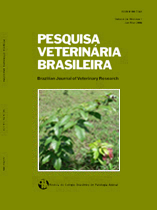 |
|
|
|
Year 2009 - Volume 29, Number 07
|

|
Doenças parasitárias em ruminantes no semi-árido brasileiro, p.563-568
|
ABSTRACT.- Costa V.M.M., Simões S.V.D. & Riet-Correa F. 2009. [Parasitic diseases in ruminants in the Brazilian semiarid.] Doenças parasitárias em ruminantes no semi-árido brasileiro. Pesquisa Veterinária Brasileira 29(7):563-568. Hospital Veterinário, CSTR, Universidade Federal de Campina Grande, Campus de Patos, 58700-970 Patos, PB, Brazil. Email: franklin.riet@pq.cnpq.br
Clinical cases and diagnostic specimens from ruminants received by the Veterinary Hospital of the University of Campina Grande in Patos, Paraíba, Brazil, from January 2000 to August 2007, were reviewed to evaluate some epidemiological aspects of parasitic diseases of ruminants in the semiarid region of Paraíba and neighboring states. The region has an annual rainfall of about 800mm, with irregular rains concentrated in a 3 to 4-month-period, and an average annual temperature of 26°C. During those years, 163 (5.31%) out of 3,064 ruminants were affected by some parasitic disease. The most important parasitosis in goats and sheep was gastrointestinal helminthiasis, mainly hemonchosis; goats were more affected (6.24% of cases in this species) than sheep (4.7% of cases). The higher frequency of the disease in goats may be associated with higher susceptibility or due to treatment mistakes, i.e. use of the same dose for both species, which for most anti-antihelmintics is insufficient for goats. Cattle have a low rate of gastrointestinal helminthiasis (1 out of 1,113 cases). This low frequency is probably due to the farming system in the semiarid, with low stocking rate, up to one adult bovine for every 13-16 ha, and permanence of calves (susceptible) with their mothers (resistant) for nearly one year before weaning. The occurrence of eimeriosis in goats and sheep was observed in 0.76% of the cases, involving only young animals. The main cattle disease was tick fever with 14 outbreaks. Outbreaks of tick fever occur, mainly at the end of the raining season in areas of the semiarid which are marginal for tick, like plateaus and mountains of the Borborema region, irrigated areas, and areas of the basins of two rivers of the region. In the drier areas of the semiarid Rhipicephalus (Boophilus) microplus do not survive during the dry period, but tick fever can occur when cattle with ticks are introduced at the onset of the raining season. |
| |
|
|
| |
|
 |